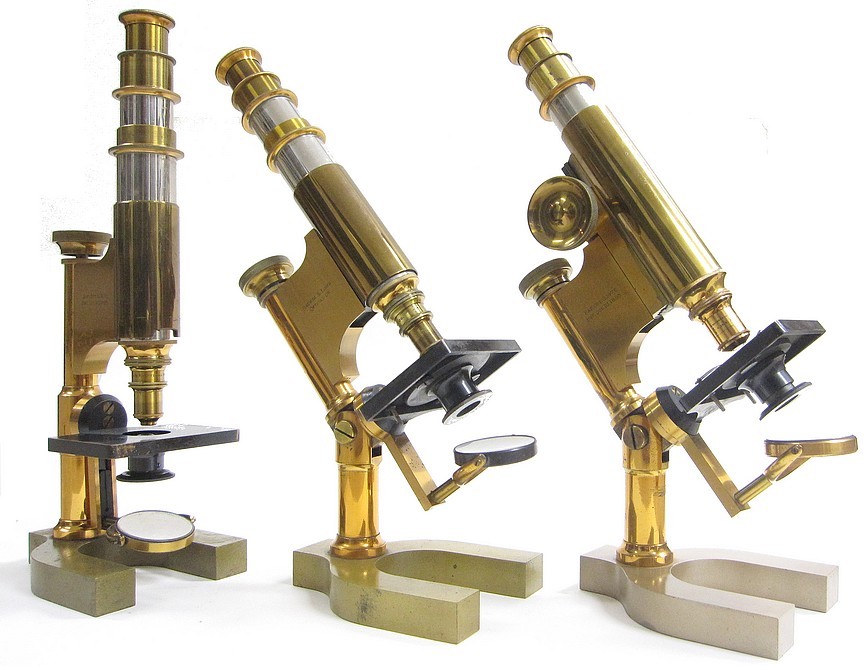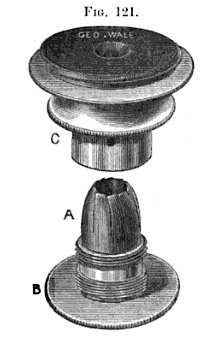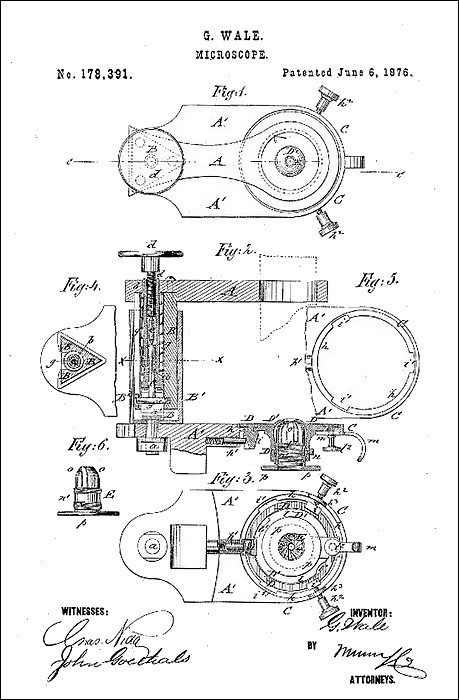
Click on each microscope for more information
Each of these microscopes is constructed in bright lacquered brass with the base having a bronzed brass finish. For each, the height of the tube can be extended by means of a drawtube. The drawtube has a Society Screw on the lower end to accommodate very low power objectives and other accessories. The main focusing adjustment of these microscopes can vary, while the fine focus utilizes a micrometer screw, which operates the patented B&L mechanism. The substage consists of a Wale type iris diaphragm, It is stamped with the George Wale patent date, June 6, 1876. The mirror is adjustable on its swinging arm and is double sided with plane and concave glasses; it can be positioned above the stage to illuminate opaque objects. These microscopes are usually supplied with two B&L eyepieces and two B&L objectives with their brass canisters.
This model was supplied in three different versions. The most elaborate version has the ability to incline and has rack and pinion coarse focusing. The most simple version lacks inclination and rack and pinion focusing. The intermediate version can incline and only has push-tube coarse focusing.
The following catalog description states that since the Faculty of the Harvard Medical School made suggestions for the design of this model, it was given the title the “Harvard Microscope”.
"The leading idea in the construction of this instrument was to get the nearest approach to the simple pattern, used so extensively in Europe, and combining with it those modern improvements, without which any microscope may be considered incomplete. Members of the Faculty of the Harvard Medical School have been interested in its construction and have made a number of valuable suggestions, which have been embodied in it. In recognition of the favor thus shown, we have given it its name. Considering the work, the various adjustments and price, it will be found to bear favorably a comparison with foreign instruments of similar construction. The stand is made entirely of brass and so proportioned that it will give the most effectiveness to the various parts. Although constructed so as to allow its convenient use in an upright position on an ordinary table, it still gives sufficient range of adjustment for all ordinary work. The base is of the horse-shoe form with a projection at the back to give it steadiness when the body is inclined. Coarse adjustment is by a sliding tube in a sleeve, provided with a spring which reduces the friction and retains a smooth movement; fine adjustment is by micrometer screw with milled head of more than ordinary size, acting on our patent movement. The main tube as a draw-tube with a mark indicating standard length. The stage is large and stiff and provided with spring clips; our iris diaphragm is attached to its lower surface in such a manner as to allow its centering and entire removal for oblique light. The mirrors are plane and concave and swing with the mirror-bar to any obliquity below the stage and above it for the illumination for opaque objects. No.515A is with solid pillar and arm while B is arranged with joint for inclination of the body."
The Gundlach patents that cover the fine adjustment mechanism and the swinging sub-stage found in this model. The limb of these microscopes is often stamped with these patent dates.
The novel iris diaphragm supplied with these microscopes is covered in the June 6, 1876 patent granted to George Wale.
Iris Diaphragms.To the " Working Microscope " of G. Wale an inexpensive and very simple and ingenious form of " iris" is adapted, shown (separated) in Fig. 121. It consists of a piece of very thin cylindrical tube A, about 3/4 inch in length and 2 in. diameter, the whole circumference of which is cut through with shears to nearly its whole length at intervals of about 1/4 inch ; by means of a screw-collar B, attached below, this cut tube is forced into a parabolic metal shell (contained within C) whose apex is truncated to an aperture of about 3/8 inch ; the pressure of the screw causes the thin metal tongues to turn and to overlap in a spiral which gradually diminishes the aperture to the size of a pin-hole. On unscrewing the collar B, the spiral overlapping of the tongues is released somewhat, and their elasticity causes the aperture gradually to expand. As adapted to the stage of the " Working Microscope," the iris, when unscrewed until its aperture is smallest, is then almost in contact with the base of the slide ; when at its largest expansion it is about 1/16 inch lower. The whole device is fitted into the opening of the stage from beneath (so as to be flush with the upper surface) with one turn of a very coarse screw on the edge of C, a far more convenient plan than the " bayonet joint."



